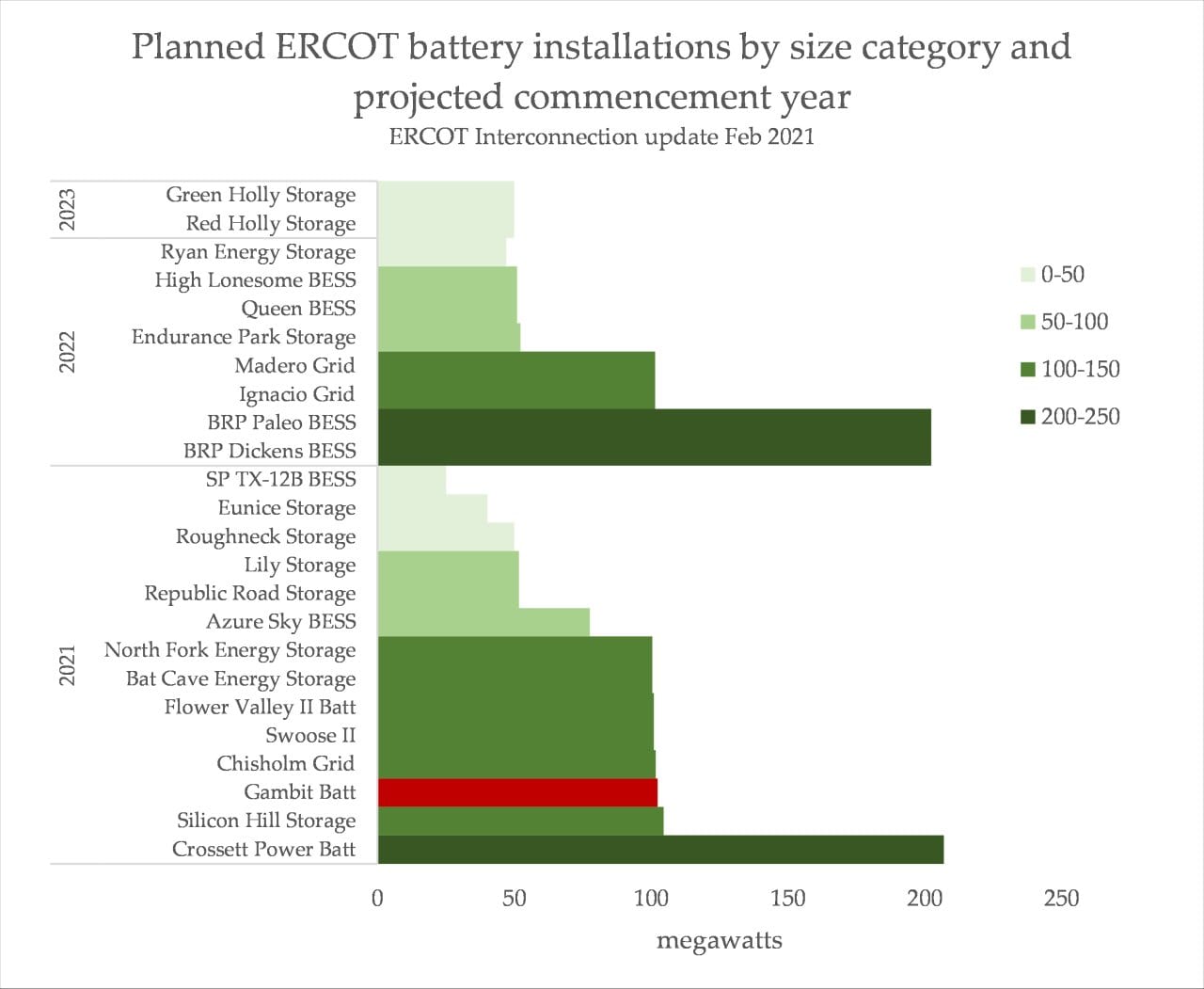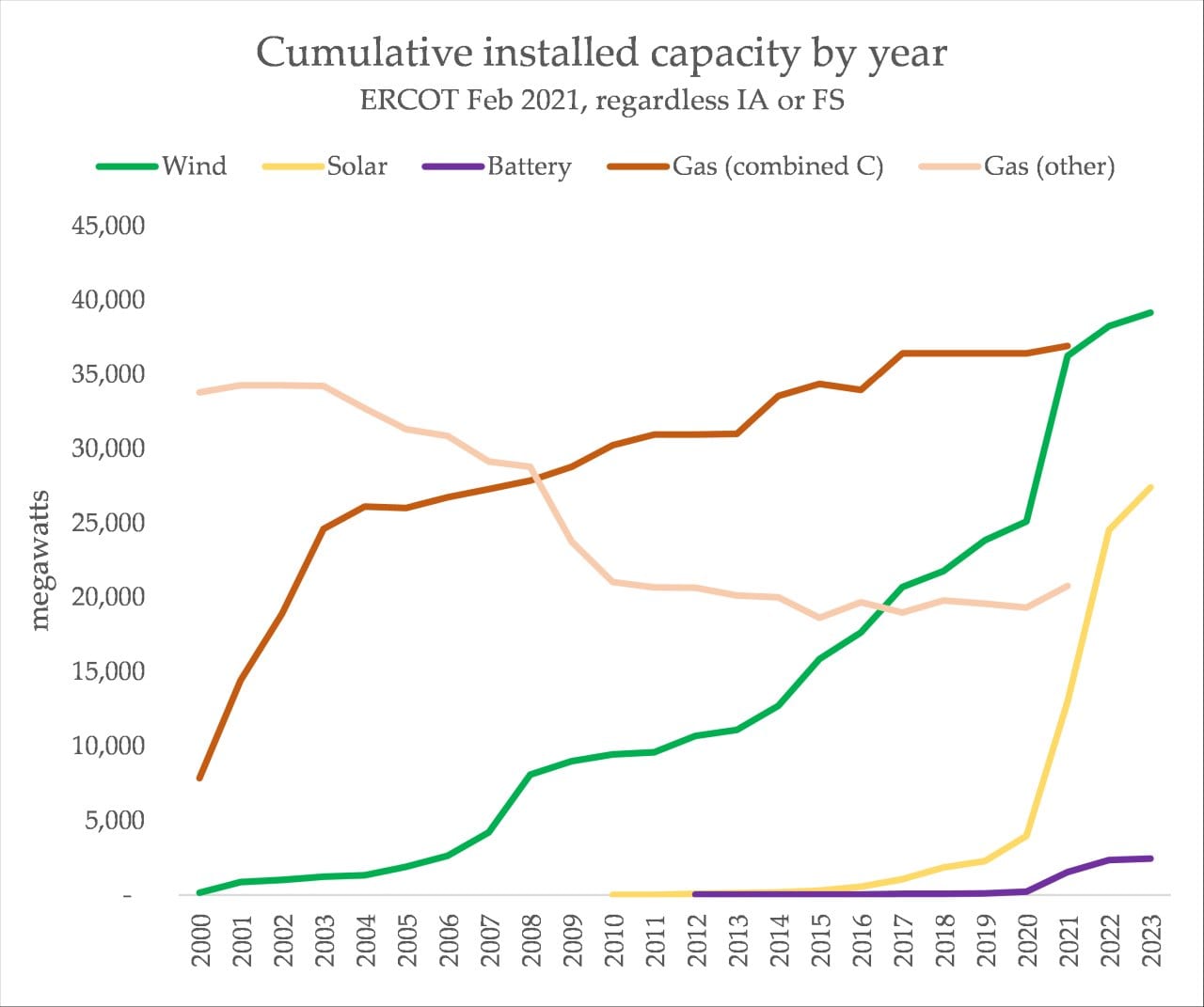A Tesla subsidiary is secretly building a 100 megawatt energy storage project in Angleton, Texas, as revealed today by Bloomberg Green‘s Dana Hull and Naureen S Malik, only weeks after a blackout resulted in most of the state’s generators and fossil fuel supply infrastructure failing during icy weather.
Operating under the subsidiary name ‘Gambit Energy Storage LLC’, workers with Tesla-emblazoned hardhats have been quietly progressing on construction in the facility, and Bloomberg further confirm Tesla’s involvement with public documents.
Musk recently moved to Texas to oversee progress on his SpaceX launches and only briefly commented on the recent blackouts that rocked the state, in which a deep freeze disabled the state’s energy assets, mostly gas and coal:
.@ERCOT_ISO is not earning that R
— Elon Musk (@elonmusk) February 17, 2021
“Hi Elon, is something like this possible in Texas?”, wrote Pankaj Vohra, in response to Musk’s jab at the state’s grid operator, ERCOT. “Yes,” Musk briefly replied.
The fast paced construction matches the launch of a 100 megawatt battery system at the Hornsdale Wind Farm in South Australia, launched with much fanfare by Musk after a state-wide blackout hit the state in 2016. At what was meant to be a ‘sod turning’ event for that system, press attendees saw a half-completed project. Only a few months ago, the project’s owners completed an expansion to a capacity of 150 megawatts and a storage depth of 194 megawatt hours.

Though the announcement came with plenty of showmanship, including an agreement to build it within a short timeframe ‘or it’s free’, the installation has quietly performed a significant role in South Australia, paying its cost to South Australian taxpayers several times over and helping to integrate new volumes of wind and solar.
While the battery was mocked by conservatives at the time, with Scott Morrison famously deriding it as a ‘big banana‘, it’s now clear that the facility has contributed significantly towards ensuring grid stability in South Australia, as its renewable energy proportion has climbed ever-higher. Mostly, it contributes ‘fast response’ style bursts of output to manage frequent, small mismatches between supply and demand. It also generates significant (but fluctuating) revenue for its owner, Neoen.
10/ Tesla Energy could represent up to 30% of the company's total revenue by the 2030s, up from roughly 6% today, according to analyst Alexander Potter of @Piper_Sandler.
— Bloomberg Green (@climate) March 8, 2021
Musk could be planning a showy reveal for the facility in Texas, akin to the publicity-heavy launch of South Australia’s battery five years ago, but the market dynamics have shifted significantly since then, with lithium-ion energy storage being far cheaper than it was. That means there is already around 2,100 megawatts of planned storage capacity due for Texas, alongside 37,000 megawatts of wind and solar, as US energy expert Jigar Shah is quoted as saying in Bloomberg.
ERCOT’s publicly available data for its queue of new generators due to be connected to its grid shows that by February 2022, almost 2,000 megawatts of battery storage will be installed, and the majority of that has had its financial security confirmed. The grid operator in fact has a special ‘priority’ focus on the installation of new battery storage projects, including monthly meetings to track issues and progress. Tesla’s ‘Gambit’ project sits among a broader mix of projects, spread across the state and many with larger capacities.
One other note in ERCOT’s data is that the Implementation Agreement (IA) for the ‘Gambit’ project under Tesla was signed in May 2020, suggesting this was in the works well prior to the February 2021 Texas blackouts.
It’s worth putting these approximate 2 gigawatts of battery storage in context – a very steep curve of new wind and solar in Texas, as also shown in ERCOT’s yearly new connections data:
These very big numbers are not limited to Texas, with a report from Wood Mackenzie and the US Energy Storage Association finding last week that the total deployed storage across America grew from just under 1,000 megawatt hours in 2019 to more than 2,000 megawatt hours in 2020:
Hey #energytwitter – I don't want to freak anyone out or anything but the latest @storage_ESA / @WoodMackenzie #EnergyStorage Monitor shows more storage came online in Q4 2020 than in 2013 through 2019 COMBINED!
The #energytransition is #energyaccelerating!
We broke the Y axis. pic.twitter.com/Q0tXBKGmny
— Dan Finn-Foley (@DanFinnFoley) March 3, 2021
Of the US states and ‘Front-of-the-meter’ storage deployments, California comprised 1,780 megawatt hours of storage depth, with 69.7 in Texas and 22 in other states, for the fourth quarter of 2020 only.
For the full year of 2020, Texas saw 116 megawatt hours installed, with 2,372 MWh in California. California, of course, attracted much critical attention mid last year as significant blackouts during a heatwave, in which gas plant failures were implicated.
As occurred in South Australia in 2016, a major blackout is being followed by a bad faith campaign of deception by conservatives blaming renewables, businesses attempting to seize on the event in the months that follow, and what seems likely to be a long period of stable yet fast-paced change in a gas-heavy grid. South Australia, Texas and California all seem to be on different stages of roughly the same path.
If Musk and Tesla decide to do a grandiose launch of the battery system, it’s likely to see a campaign of reactionary criticism, probably focused on the relative small size of the plant. But both the marketing and the reaction misunderstand the role of battery storage in integrating wind and solar, which is necessary but insufficient. Other tools like demand response, new interconnection, synchronous condensers and better planning for new sites ease wind and solar integration too, potentially up to very high volumes.
South Australia has come emerged as, inarguably, a global leader in zero emissions power. Gas output continues to decline, and the development of resources to integrate wind and solar continue. Battery storage plays a vital role in facilitating this change. Battery storage won’t be the sum of Texas’ renewable energy story, but it will probably end up quietly serving a function to Texans well into future years.










